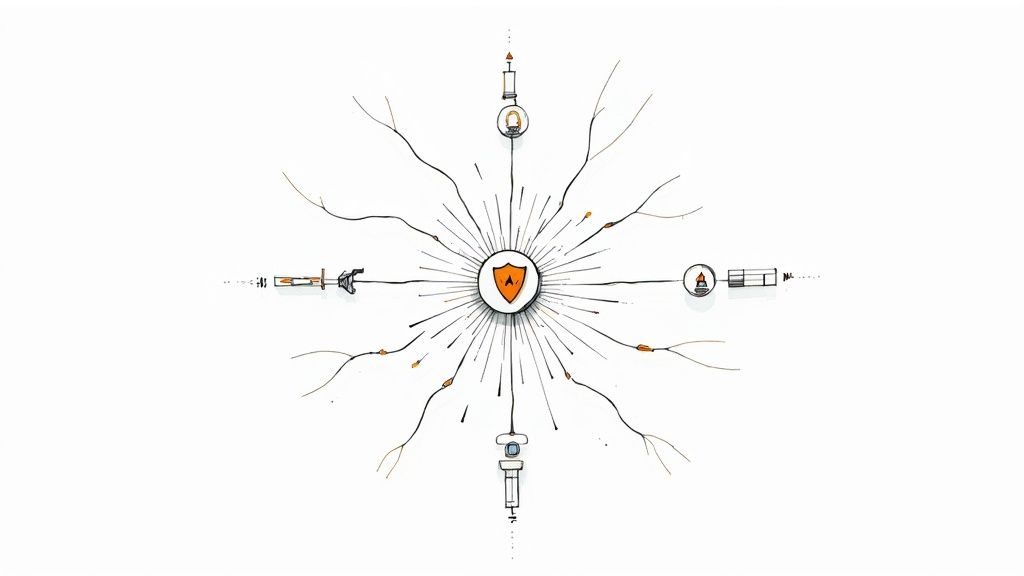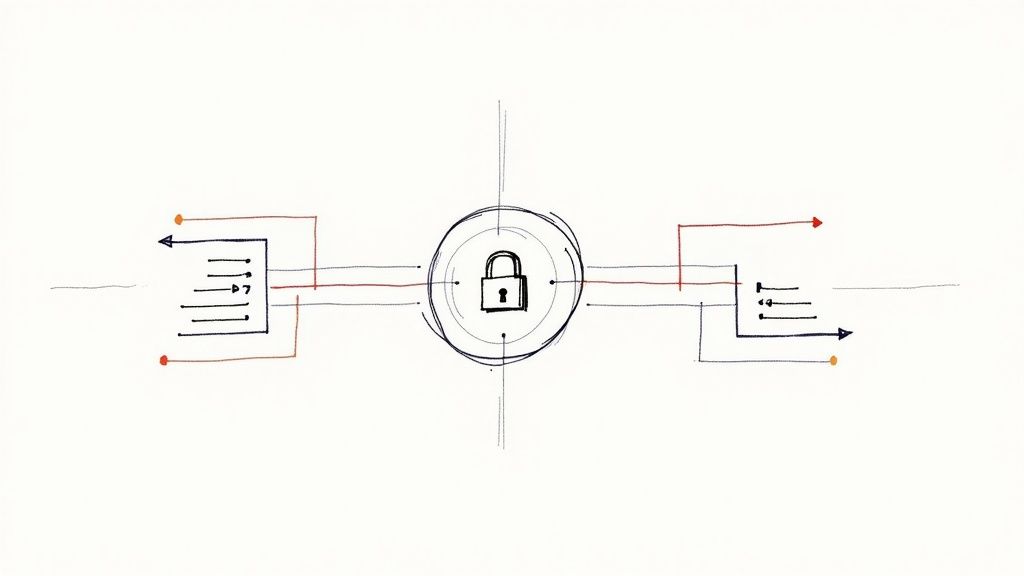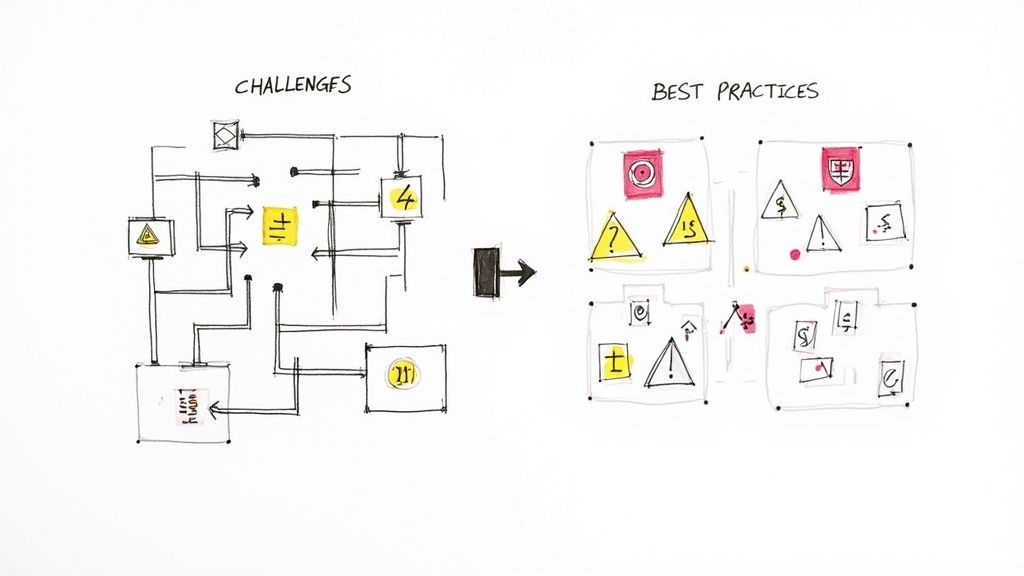Secure Code Integration: Best DevSecOps Practices

The Evolution of Secure Code Integration

Traditionally, security was an afterthought in the software development lifecycle (SDLC). This reactive approach meant vulnerabilities were often discovered late, leading to expensive fixes and project delays. The rise in sophisticated cyberattacks has changed this perspective.
Secure code integration is now a critical business imperative.
From Afterthought to Forethought: Shifting the Security Paradigm
Leading organizations now understand that security must be integrated from the very beginning of the SDLC. This proactive approach, known as shift-left security, emphasizes building security into each development stage.
This includes training developers to write secure code and integrating automated security testing into the CI/CD pipeline. This represents a fundamental shift in software development.
The Business Impact of Secure Code Integration
Secure code integration offers benefits beyond just breach prevention. While financial losses from security incidents can be substantial, the hidden costs are often greater. These include damage to customer trust, regulatory penalties, and decreased market value.
Maintaining regulatory alignment is also crucial. Understanding compliance frameworks like DCAA Compliance is essential. Organizations prioritizing secure code integration often see faster development speeds and improved code quality. Addressing security early reduces the need for costly rework later.
Embracing Security as a Business Enabler
The importance of secure code integration has grown significantly due to increasing cybersecurity threats. One example is the implementation of PCI DSS v.4.0 for organizations processing payment card information. This framework focuses on a risk-based approach to security, emphasizing continuous compliance.
Secure coding practices and regular vulnerability assessments are crucial for protecting sensitive data and building consumer trust. Learn more about these trends in secure coding here. Forward-thinking organizations now view security as a business enabler. They recognize that strong security practices create a competitive edge.
By prioritizing secure code integration, these organizations mitigate risk and build a foundation for innovation and growth. This proactive approach fosters customer trust, attracts talent, and drives business success.
Building Your DevSecOps Transformation Strategy

Building a solid DevSecOps strategy requires a practical approach. It's about weaving security into the development pipeline, shifting from reactive security measures to proactive ones. Security becomes an integral part of the development process, not a separate, final stage. This transformation can change security from a potential roadblock to a competitive edge for organizations.
Overcoming Resistance and Fostering Collaboration
One of the biggest hurdles in implementing DevSecOps is resistance from development teams. Developers can often see security as something that slows down development and innovation. To address this, organizations need to create a culture of shared responsibility for security, bridging the gap between security and development teams.
Involving developers in security discussions and decisions from the beginning helps build buy-in and a sense of ownership. Providing developers with the proper training and tools allows them to adopt security practices without feeling overwhelmed.
Implementing Security Automation That Developers Embrace
Automating security processes is a central principle of successful DevSecOps. However, this automation needs a strategic approach to avoid frustrating developers. Instead of just adding more security tools to the CI/CD pipeline, focus on integrating security checks relevant to the specific project and development phase.
For example, automated static analysis tools can catch potential vulnerabilities early on, while dynamic analysis tools can test running applications for security flaws. Tools like Mergify can further streamline this process, automating pull request updates and ensuring stable code integration.
Establishing Security Gates Without Slowing Innovation
Security is crucial, but it shouldn't sacrifice speed and innovation. Creating effective security gates within the development pipeline requires balance. These gates should provide vital security checks without causing bottlenecks.
Prioritizing vulnerabilities based on actual risk, rather than generic severity scores, can help achieve this. Addressing high-risk vulnerabilities first lets developers concentrate on the most critical security issues. This focused approach ensures effective security without hindering the overall development process.
To help illustrate the various approaches to DevSecOps implementation, the following table provides a comparison:
DevSecOps Implementation Approaches
| Approach | Key Characteristics | Best For | Implementation Complexity | Security Effectiveness |
|---|---|---|---|---|
| Shift-Left | Integrates security early in the development cycle | Organizations focusing on proactive security | Moderate | High, as vulnerabilities are identified and addressed early |
| Security as Code (SaC) | Automates security policies and configurations | Organizations seeking to streamline security automation | Moderate to High | High, improves consistency and reduces human error |
| Continuous Security Monitoring | Implements ongoing security monitoring and analysis | Organizations needing real-time visibility into security posture | High | High, allows for rapid response to security incidents |
This table summarizes different implementation strategies, highlighting their key features, ideal use cases, and levels of complexity. Choosing the right approach depends on the specific needs and maturity of the organization.
The growth of DevSecOps has greatly influenced how secure code is integrated into software development. DevSecOps combines security measures with traditional DevOps practices. This lets teams build security checks directly into the development process. Statistics show 36% of respondents currently use DevSecOps, up from 27% in 2020. A significant 96% believe their organization would benefit from automating security and compliance processes. Find more statistics here. This shows a growing understanding of the importance of automated security within the development lifecycle.
Measuring and Communicating Security Improvements
Measuring and communicating security improvements demonstrates the value of DevSecOps. These metrics should be meaningful to both technical teams and leadership. Tracking key metrics like the number of vulnerabilities identified and fixed, the time to resolve security issues, and the overall code quality improvement provides valuable data.
These metrics can then show the positive impact of DevSecOps on the organization's security posture and business goals. Showcasing the value of these improvements reinforces the importance of DevSecOps within the overall development strategy. This data-driven approach to demonstrating success helps secure ongoing investment and support for DevSecOps initiatives.
Securing Your Cloud-Native Code Ecosystem

As organizations increasingly embrace cloud-native architectures, they encounter new and evolving security challenges. This necessitates a shift in approach and the adoption of specialized security strategies. This section explores how leading teams are prioritizing secure code integration within their cloud-native environments, addressing infrastructure code, containers, and APIs, all while maintaining rapid deployment speeds.
Managing Cloud Permissions
Effective cloud permission management is a cornerstone of secure code integration. Over-privileged accounts present a significant security risk, potentially granting malicious actors access to sensitive data or allowing them to disrupt critical operations.
Therefore, adhering to the principle of least privilege is crucial. This practice involves granting only the minimum necessary permissions to each user or service, effectively limiting the potential damage from compromised credentials and minimizing the impact of a security breach.
Regularly auditing cloud permissions helps identify and correct any instances of excessive access. Automated tools can streamline this auditing process and ensure continuous compliance, maintaining a robust security posture.
Implementing Infrastructure-as-Code Security
Infrastructure-as-Code (IaC) offers substantial advantages for managing and provisioning cloud resources. However, it also introduces potential security vulnerabilities. Misconfigurations within IaC can expose systems to various attacks.
Integrating security scanning into the IaC pipeline is essential to identify and address these misconfigurations before deployment. This proactive, shift-left approach prevents vulnerabilities from reaching production environments. Tools can scan IaC templates for common security weaknesses, like open ports or insecure configurations, significantly reducing the risk of deploying vulnerable infrastructure.
Establishing Container Security Practices
Containerization has revolutionized software development, yet it also presents new security considerations. Securing container images is paramount to prevent vulnerabilities from infiltrating the runtime environment.
Robust container security practices involve scanning images for known vulnerabilities and ensuring they are built from trusted base images. Minimizing the attack surface by running containers with minimal privileges further limits the potential impact of exploits.
This combined approach of proactive scanning and runtime protection establishes a strong defense against container-based attacks. By 2025, securing code repositories, particularly within cloud-native environments, has become a top priority. According to the State of Code Security Report, 35% of GitHub repositories are public, providing easy access for malicious actors, and 61% of organizations have public repositories containing sensitive cloud secrets. More detailed statistics can be found here: https://www.wiz.io/blog/state-of-code-security-report-2025.
The following table summarizes common security risks associated with cloud repositories and provides mitigation strategies:
Cloud Repository Security Risks and Mitigations
| Risk Category | Potential Impact | Detection Method | Mitigation Strategy | Implementation Difficulty |
|---|---|---|---|---|
| Over-Privileged Accounts | Data breach, service disruption | Access audits, vulnerability scanning | Principle of Least Privilege, regular reviews | Medium |
| IaC Misconfigurations | System exposure, unauthorized access | Static code analysis, security scanning | Automated security checks in CI/CD pipeline | Low |
| Vulnerable Container Images | Runtime exploits, data compromise | Image scanning, vulnerability databases | Secure base images, minimal privileges | Medium |
| Public Repositories with Secrets | Credential theft, unauthorized access | Secret detection tools, code analysis | Access control, secrets management | Low |
This table highlights the importance of implementing a multi-layered security approach to protect cloud repositories from various threats.
Balancing Security and Speed
While security is paramount, it shouldn’t impede development velocity. Successful organizations strive to balance security requirements with the speed advantages of cloud-native development. This often involves automating security processes and seamlessly integrating them into the development workflow.
Tools like Mergify can be invaluable for automating pull requests and implementing merge protections, streamlining the development process while enhancing code security. By integrating security into the development process, rather than treating it as a separate step, organizations can achieve both robust security and rapid deployment cycles. Building a DevSecOps transformation strategy can be simplified with tools like Applicant Tracking Systems. In this way, security becomes an enabler of speed, not a bottleneck, allowing organizations to confidently harness the power of cloud-native development while maintaining a strong security posture.
Mastering Vulnerability Management That Actually Works

Effective vulnerability management is more than just running scans. It's about shifting from a reactive checklist to a proactive strategy that strengthens your overall security posture. This means understanding the real-world risks and focusing on what truly matters.
Prioritizing Vulnerabilities Based on Real-World Risk
Many organizations depend on vulnerability scanners that assign generic severity scores. However, these scores often fall short of reflecting the actual exploitability of a vulnerability in a specific environment. This can lead to misplaced priorities, with developers spending valuable time on low-risk issues while critical vulnerabilities go unpatched.
Instead, successful organizations prioritize vulnerabilities based on the likelihood of exploitation. Factors such as accessibility, location of the vulnerability, and potential impact of a successful attack all play a role.
For example, a high-severity vulnerability tucked away in an internal system with limited external access poses less of an immediate threat than a medium-severity vulnerability in a public-facing application. This risk-based approach allows security teams to focus on the most critical vulnerabilities first, ensuring the best use of resources.
Reducing False Positives and Developer Frustration
Vulnerability scanners often generate numerous false positives. This can lead to developer frustration, wasted time, and ultimately, a sense of apathy towards security alerts. Effective vulnerability management includes strategies to minimize these false positives.
Here are some key techniques:
- Fine-tuning scanning tools for better accuracy
- Using multiple scanning techniques to cross-validate findings
- Establishing a clear process for developers to challenge and dismiss false positives
Providing developers with context around security alerts is crucial. Explaining the potential impact of a vulnerability and providing clear remediation steps can improve understanding and encourage prompt action. This collaboration between security and development teams is a cornerstone of effective vulnerability management.
Establishing Effective Remediation Workflows
Remediation workflows should integrate seamlessly with existing development processes. This requires close collaboration between security and development teams to define clear priorities and realistic timelines. Tools like Mergify can automate parts of this process, such as managing pull requests and ensuring security fixes are integrated efficiently.
This collaborative approach ensures security fixes are treated with the same level of importance as other development tasks. Consistent tracking of remediation progress and regular updates to both teams promotes accountability and keeps everyone informed. By making security a part of the regular development cycle, organizations significantly improve their overall security posture.
Measuring Security Improvement in Meaningful Ways
Measuring security improvements is essential for demonstrating the value of effective vulnerability management. Key metrics to track include the number of vulnerabilities discovered and remediated, the time taken to remediate vulnerabilities, and the overall reduction in risk.
Communicating these metrics clearly to both technical teams and executives highlights the positive impact of security efforts. For example, demonstrating a reduction in the number of high-risk vulnerabilities over time provides tangible evidence of progress. This data-driven approach supports continued investment in security initiatives. Furthermore, regular security assessments provide a broader view of security maturity and identify areas for future improvement. Shifting left, by integrating security testing earlier in the development lifecycle, can drastically reduce the cost and effort required to address vulnerabilities down the line.
Building a Security Culture That Developers Embrace
Technical solutions are crucial for secure code integration, but they're only one piece of the puzzle. A truly successful strategy requires developers who are genuinely invested in security. This section explores how organizations can cultivate security-minded cultures where developers actively prioritize protection.
Fostering a Security Mindset
Building a security-focused culture starts with a shift in perspective. Instead of seeing security as a roadblock to rapid development, it should be a fundamental value. This means making security a priority from the very beginning of a project and weaving it into every stage of the Software Development Life Cycle (SDLC).
For example, incorporating automated security checks into the CI/CD pipeline, like those offered by Mergify, helps developers catch vulnerabilities early and address them efficiently. This early integration makes security a normal part of development, not a last-minute scramble.
Security Training That Sticks
Traditional security training can be dull and ineffective. Organizations are finding greater success with more engaging and active learning methods.
- Interactive workshops: These offer hands-on learning experiences.
- Gamified learning platforms: These make learning fun and competitive.
- Vulnerability hunting exercises: These provide real-world experience.
Additionally, supporting developers in obtaining security certifications shows investment in their professional growth and underscores the value of security expertise. This investment pays off by minimizing vulnerabilities and strengthening the organization's overall security.
Creating Security Champions
Security champions are developers within teams who actively promote security best practices. They serve as a link between security and development teams, fostering communication and collaboration. These individuals play a key role in driving security adoption from within the development ranks.
Recognizing and empowering these champions can significantly extend the security team's impact. Providing them with specialized training and resources equips them to effectively guide their colleagues, building a network of security advocates throughout the organization.
Hands-On Learning and Real-World Application
Learning secure coding is most effective when developers can apply their knowledge in realistic scenarios. This reinforces the significance of security and demonstrates how vulnerabilities can appear in real-world projects.
- Interactive coding challenges: These offer engaging and practical experience.
- Capture-the-flag (CTF) exercises: These simulate real-world attack scenarios.
These practical exercises enhance security skills and build confidence in applying secure code principles. Developers gain a deeper understanding of the consequences of insecure code and how to prevent it.
Furthermore, integrating regular security discussions and code reviews into the team's workflow encourages ongoing improvement. Peer feedback and shared learning create a supportive atmosphere where security becomes a shared responsibility. By cultivating a culture where security is valued, taught effectively, and championed internally, organizations can ensure that secure code integration becomes a natural part of the development process. This results in fewer vulnerabilities, faster remediation, and a more robust overall security posture.
Navigating Compliance Without Killing Innovation
Security regulations are often seen as roadblocks to innovation. However, some organizations are turning compliance into a competitive edge. This involves efficient management of security controls, automating evidence collection, and establishing continuous monitoring.
Mapping Security Controls Across Multiple Frameworks
Many organizations struggle with complying with multiple security frameworks. Regulations like SOC 2, ISO 27001, and HIPAA each have their own requirements, creating a complex web of controls. Instead of treating each framework separately, organizations can map controls across different standards.
For example, an access management control for SOC 2 might also fulfill a similar requirement for ISO 27001. Finding these overlaps reduces redundancy and simplifies compliance. This strategic approach addresses multiple frameworks efficiently, freeing resources for innovation.
Automating Compliance Evidence Collection
Gathering audit evidence can be tedious and time-consuming. Manually collecting documentation and reports disrupts workflows and creates overhead. Automating this process reduces the burden on security and development teams.
Tools can automatically collect evidence like system logs, configuration settings, and vulnerability scan results. This automation saves time, improves accuracy, and ensures consistent evidence collection. Teams can then focus on more strategic security initiatives.
Continuous Compliance Monitoring
Traditional compliance relies on periodic assessments. This reactive approach can leave organizations vulnerable between audits. Continuous compliance monitoring provides real-time visibility into security posture. Automated tools can constantly monitor systems and alert teams to potential violations.
This proactive approach helps address issues quickly, avoiding surprises during audits. It’s like having the tools to ensure a building is always up to code, ready for inspection at any moment. This proactive posture strengthens security and reduces non-compliance risks.
Balancing Security and Speed
Successful teams know security and speed aren’t mutually exclusive. They create systems that satisfy auditors and empower developers to move quickly. Automating security checks within the development pipeline, for instance, allows early identification and remediation of vulnerabilities.
This “shift-left” approach improves security without slowing things down. Tools like Mergify automate pull request updates, merge protections, and other key aspects of the CI/CD pipeline. This ensures security is integrated into the development workflow, enabling teams to deliver secure code quickly. By adopting these strategies, organizations can transform compliance from a burden into an innovation driver, supporting agility and growth.
Ready to streamline your development workflow and enhance code security? Explore how Mergify can help your team by visiting Mergify.





